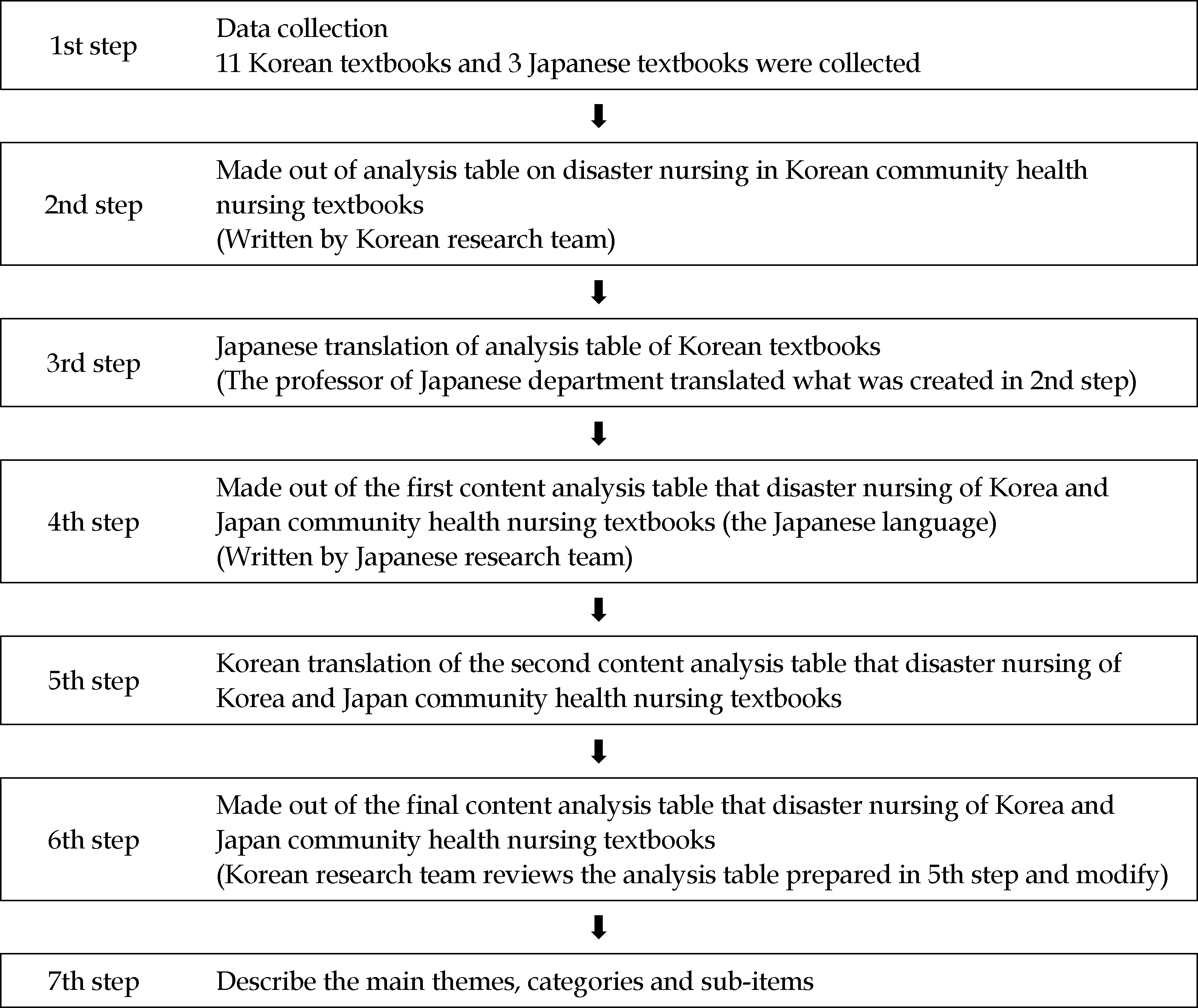Abstract
Purpose
The purpose of this study is to analyze the contents of disaster nursing education at universities in Korea and Japan, with focus on textbooks.
Methods
Disaster nursing contents from 11 Korean community health nursing textbooks and 3 Japanese disaster nursing textbooks were analysed.
Results
Three themes and 8 categories of disaster nursing content in the selected textbooks were analyzed. The themes classified include ‘understanding of disaster’, ‘disaster management’ and ‘disaster management system’. The theme of ‘understanding of disaster’ consists of such categories as ‘disaster concept/outline’, ‘classification of disaster’, ‘disaster management step’ and ‘disaster impact’. The theme of ‘disaster management activities’ consists of categories such as ‘disaster management activities’ and ‘disaster nursing’. The theme of ‘national disaster management system’ consists of categories like ‘national disaster management system’ and ‘international disaster relief’. From the comparison of disaster nursing education in the two countries, we found that themes were similar but there were differences between the two countries in content configuration. Korea and Japan have adopted the framework of International Council of Nurses for disaster nursing education. Korea stressed legal and ethical capabilities, while Japan included psychological support for disaster management service providers.
Go to : 
References
1. An YH, Kwon MS, Park JK, Song NH, Yun OS, Lee SY, et al. Community/public health nursing. Seoul: Hyunmoonsa;2014. p. 651.
2. Landesman LY. Public health management of disaster: the practice guide. 3rd ed.Lee IS, Kang KH, Kong HJ, Koh Y, Kim HS, Moon HJ, et al, translator. Washington, DC: American Public Health Association;2012.
3. Robert B, Elaine D. International disaster nursing. Port Melbourne, Vic.: Cambridge University Press;2010. p. 614.
4. Veenema TG. Disaster nursing and emergency preparedness for chemical, biological, and radiological terrorism and other hazards. 3rd ed. New York, NY: Springer Publishing Company;2013. p. 764.
5. Yamamoto A. Development of disaster nursing in Japan, and trends of disaster nursing in the world. Japan Journal of Nursing Science. 2013; 10(2):162–169. https://doi.org/10.1111/jjns.12042.

6. World Health Organization and International Council of Nurse. ICN Framework of disaster nursing competencies [Internet]. Geneva: World Health Organization;2009. [cited 2017 March 25]. Available form:.
7. Lee YR, Lee MH, Park SK. Development of the disaster nursing competency scale for nursing students. Journal of the Korea Society of Disaster Information. 2013; 9(4):511–520.
8. Lee OC. An analytical review of disaster nursing competencies in Korea: 1995-2013. Journal of Korean Society of Hazard Mitigation. 2014; 14(6):221–230. https://doi.org/10.9798/KOSHAM.2014.14.6.221.

10. Um DC, Park YI, Oh HJ. Disaster preparation of visiting nurses in public health centers. The Journal of Korean Academic Society of Nursing Education. 2016; 22(2):240–249.

9. Park HY. Factors influencing the nursing core performance ability of emergency room nurses [master's thesis]. [Incheon]: Gachon University;2015. p. 47. https://doi.org/10.5977/jkasne.2016.22.2.240.
11. Woo CH, Yoo JY, Park JY. Experience, awareness and preparedness of disaster among nursing college students. Korean Review of Crisis & Emergency Management. 2015; 11(11):19–35. https://doi.org/10.14251/krcem.2015.11.11.19.

12. Kim HJ. A study on disaster preparedness, core competencies and educational needs on disaster nursing of nursing students. Journal of the Korea Academia-Industrial cooperation Society. 2015; 16(11):7447–7455. https://doi.org/10.5762/KAIS.2015.16.11.7447.

13. Korea Armed Forces Nursing Academy. Actual of the latest disaster nursing. 3rd ed. Paju: Soomoonsa;2017. p. 510.
14. Kim OS, Seo BD, Kim BR, An HJ, Byeon HS, Shin KM, et al. Emergency and disaster nursing. 2nd ed. Paju: Soomoonsa;2017. p. 596.
15. Lee YR, Han SJ, Cho CM. Disaster experience, perception and perceived stress of nursing students. The Korean Journal of Stress Research. 2016; 24(4):237–242. https://doi.org/10.17547/kjsr.2016.24.4.237.

16. Achora S, Kamanyire JK. Disaster preparedness: Need for inclusion in undergraduate nursing education. Sultan Qaboos University Medical Journal. 2016; 16(1):15–19. https://doi.org/10.18295/squmj.2016.16.01.004.

17. Jose MM, Dufrene C. Educational competencies and technologies for disaster preparedness in undergraduate nursing education: An integrative review. Nurse Education Today. 2014; 34(4):543–551. https://doi.org/10.1016/j.nedt.2013.07.021.

18. Choe MA, Kuwano N, Bang KS, Cho MK, Yatsushiro R, Kawata Y. Japanese and Korean nursing students' motivation for joining disaster relief activities as nurses in the future. Journal of Trauma Nursing. 2017; 24(3):208–218. https://doi.org/10.1097/JTN.0000000000000291.

20. Lee DH, Kim JY, Kang HS, Lee HR. The current status and im- plications of disaster management system and psychological support system in disaster response in Japan. The Journal of the Korea Contents Association. 2016; 16(7):73–90. https://doi.org/10.5392/JKCA.2016.16.07.073.
21. Lee OC. Trends of nursing research on disasters in Korea. Journal of Korean Public Health Nursing. 2014; 28(3):432–444. https://doi.org/10.5932/JKPHN.2014.28.3.432.

22. Sakai A, Kikuchi S. Disaster nursing to integrate nursing expertise into practice. 2nd ed. Tokyo: Nankodo;2015. p. 342. http://www.nankodo.co.jp/g/g9784524266883/.
23. Lee YH. Social responses to disasters: from disaster management to disaster governance. In the Age of Anxiety, Looking for A Way to Sociology. 2014. June 20-June 21; Daejeon KAIST. Daejeon: The Korean Sociological Association;2014 June. p. 598.
24. Lee JH. Improving disaster safety education for disadvantaged disaster-stricken families - focusing on multi-cultural families. 2016 The Korean Association for Public Administration Winter Congress and Regular General Meeting. 2016. Dec 9-Dec 10; Korea University, Seoul: The Korean Association for Public Administration; 2016 Dec.1961.
25. Yang CS. The legal theoretical analysis of the concept of risk, disaster and safety. Public Law Journal. 2015; 16(2):188–216. https://doi.org/10.31779/plj.16.2.201505.008.
26. Kim SW. A study on the role of international law on international disaster response. Dong-A Law Review. 2011; (53). 753–779.
Go to : 
Table 1.
Understanding of Disaster
Table 1.
Understanding of Disaster (Continued)
Table 2.
Disaster Management
Table 2.
Disaster Management (Continued)
Table 3.
Disaster Management System




 PDF
PDF ePub
ePub Citation
Citation Print
Print



 XML Download
XML Download